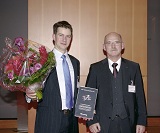Research Award for radio in the electric car

Listening to a car radio is almost a miracle in this age of electric vehicles, because electromagnetic interference from motor controllers makes receiving radio waves almost impossible. But thanks to Dr.-Ing. Eckart Hoene, power electronics expert and recipient of the 2011 Fraunhofer IZM Research Award, automotive manufacturers like Daimler, BMW and VW do not have to abandon the traditional car radio.
Background
To convert electrical energy into mechanical energy, as takes place in electric vehicles, frequency converters are employed. They control the direction and rate of rotation in electric motors. However, because such efficient converters have steep switching flanks or, in other words, slice the electrical energy into pieces at a rate of millionths of a second, they produce electrical noise has a number of effects, particularlyit completely overrides any receiving devices in the operating environment. This unwanted effect is generally understood as a problem of electromagnetic compatibility (EMC).
To solve this problem, all motor cables have to be shielded appropriately and the motor itself has to be comprehensively insulated. Using specialized filters between the converter and motor can also help improve electromagnetic compatibility. Even the system design, such as how a cable is laid out, can play a crucial role.
About Dr.-Ing. Eckart Hoene
Eckart Hoene’s unique contributions to these questions has seen him become an internationally renowned expert on EMC. Gone are the days when this Fraunhofer researcher with a PhD in Engineering would register himself at professional conferences; rather, he has long been a regular guest, invited to explain the tips and tricks of power electronics to even the big names in automotive technology. Apart from the relevant German automotive manufacturers and suppliers, more and more of his customers include US and Japanese companies. Basically he has a hand in all new commercial releases of electric vehicles. Of course, the 41-year-old, who is head of the nine-member research group “Power Electronic Systems”, has gained a colossal amount of experience from this, which he is now gladly passing on to guest scientists from Korea, Japan and Germany. For example, the analysis techniques developed by Hoene in simulations and experiments can be used to predict where components should be placed to optimize electromagnetic compatibility. The EMC specialist can also provide recommendations on the quality of insulation and components. How densely should the shielding be woven? Can several cables be bundled to reduce weight?
But not only electric vehicle design benefits from his techniques. Hoene also provides designs that maintain specified thresholds for solar plants, wind power equipment and industrial converters. A new, increasingly important area for the researcher is preventing interference in applications for aeronautics.
Award ceremony
Eckart Hoene, who has been conducting research in this area for over 14 years, received the Fraunhofer IZM Research Award for the “Development and Industrial Implementation of Design Processes for Electromagnetic Optimization of Power Electronics”. Fraunhofer IZM Institute Head Prof. Dr. Klaus-Dieter Lang, with many of Hoene’s colleagues from research and industry on hand, presented him with the award on December 21 2011 at the Berlin headquarters of the DZ BAMK.
Last modified:
 Fraunhofer Institute for Reliability and Microintegration IZM
Fraunhofer Institute for Reliability and Microintegration IZM